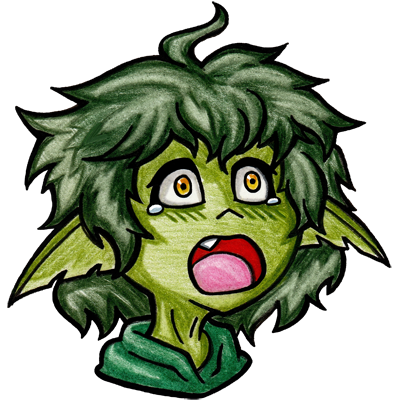


I make comics sometimes: https://linktr.ee/ahdok





I discussed whether or not this was acceptable content with the moderators and creators of this community before I started, and they’re supportive of artists posting their RPG comics here, it’s a part of the community. The community description even reflects this.
Refering to the comics from multiple creators here, not just me: These comic series do spawn actual memes often enough to be a good source of new funnies, but because they’re ongoing stories, it helps for people to be able to follow along.
If you don’t like this, you have a simple remedy available: You can just block me and never see another one again. You don’t have to be mean to random people on the internet.


I double post to the Fediverse! (you can see the mastodon address watermarked on the comics, and my non-ttrpg comics go there too.)
While Fediverse platforms are a relatively small part of my audience, I’m always skeptical that other platforms can last through poor moderation policies, whereas federated platforms will exist so long as people are enthusiastic to keep them running…


Bonus Konsi drank a little bit too much this time.

A fun thing people often forget about Mage Armor is that you can cast it on other people, which is occasionally even helpful!


While Mystery doesn’t have counterspell, Faelys does, and we own a hat of disguise.


You’d probably be able to do that and win the match, but, well, there’s a few problems…
First of all, Addis is a Tymoran priestess with level 5 spells, so she’d be pretty difficult to take down quickly unless you were serious adventurers. Chances of pulling it off without a hitch are non-zero. We don’t know for sure what is and is not on Addis’ spell list, but if we imagine it’s similar to Konsi’s list well… Konsi always has Dimension Door prepared, grabbing her would be very difficult.
Secondly, this is Konsi’s boss, you might win the match by default, but the repercussions within the temple would be much worse.
Third, Konsi would never approve of kidnapping anyone who wasn’t evil… She’s too much of a good bean.
Probably the biggest problem is that the entire point of this match is to have Konsi play a high-stakes poker match under scrutiny, to prove that she legitimately has skill at the game, and doesn’t cheat. They’re staging this whole thing to head off accusations of foul play… Kidnapping your opponent and winning by default doesn’t exactly solve the problem!


OotS has SO much text per strip, I could really do a lot with that kind of real estate.


It is an artifact, the “Forgeringer”.
Some artifacts might be powerful enough to have function inside anti-magic fields… although the Forgeringer has never displayed that kind of power. More problematic though, it’d be kind of difficult to use a hammer in the middle of a poker match undetected.


Exposition’s really difficult in comic format. People don’t really want to read a full page of text when they’re reading comics, so you got to find some ways to at least give it some visual flair…


Faelys has negative tact.


Bonus Konsi, as usual



Since some people’s clients can’t properly display tall images, here’s the comic split in two for readability.


If that is ALSO not helpful to you, I recommend looking at it on my site


I am assured it was 2e


My fiancee played a whole campaign of Apocalypse World! She enjoyed it!
Finally, there’s the hardcore simulationist angle, which I ignored completely above.
Many fantasy writers, whether that be books, shows, computer games, or RPG media… know what a human is and can do, and design the humans in their setting to comport with their experiences of what a human is from the real world.
It serves as a kind of grounding baseline, a foundation of familiarity that doesn’t need any work from the audience. “Ah yes, a human. I know what that does.” A useful starting point that ensures the audience has something low-concept and relatable in an otherwise high-concept offering.
With a simulationist mindset, humans are often the “default”, and least “fantastical” of the species in the world, because there’s an established preconception of what humans are like.
Other species can have supernatural dexterity and grace, or magic gifts, or strange relationships with the laws of physics, because they’re made up, and the mundanity of the human serves as a mirror that highlights and emphasizes the fantastical elements of the other species.
This approach isn’t so much an attempt to incentivise diversity as it is just our natural inclination to not interrogate the known and familiar. Of course humans don’t live for a thousand years, or have supernatural strength, or an immunity to poisons, we know what humans are like.
It’s a fairly small and easy leap to invent a new species and say “this species is immune to fire.” It’s a leap to ask “what if humans were immune to fire?”, and many people never even consider playing with that, because in our minds, humans aren’t fantastical creatures.
Here’s a surprising outlier from this trend:

It is legitimately impressive to see a game manage a spread like this, most MMOs and rpgs see an overwhelming lead for the “human” choice, whereas in BG3 it’s just equally popular with half-elf and elf.
There’s a lot that’s been said about BG3 and how it approaches the roleplaying game hobby, how their approach to presentation and roleplaying differs from the computer RPG genre in general, and how it relates to DnD, where people feel that the game made a positive contribution and where people feel that it didn’t. I won’t get into that, because that’s a series of essays all by itself.
Anyway, for games of this style, where you offer a generally cosmopolitan setting with a range of viable options, of which one is human, it’s distinctly unusual to see a spread like this
AND YET.
With the exception of dragonborn, (which often skews upwards as an outlier by the “dragons are cool” factor.) there’s a generalized trend in this graph with “most like a human” on the left, and “least like a human” on the right.
The most popular choices are “looks like a human” and “looks like a human with funny ears”, then progresses through “looks like a human, but a funny colour” and then through “wildly different bodytype”, with githyanki landing at the bottom for a host of reasons outside of what I discussed above.